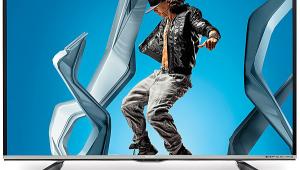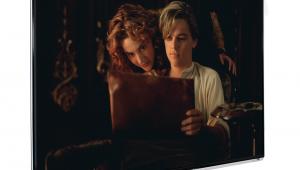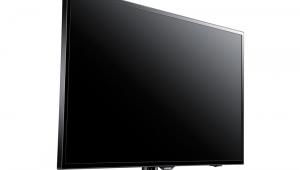Samsung LN55A950 LCD HDTV
 Price: $4,999 At A Glance: Exceptional black level and shadow detail• Accurate color & superb resolution • Superior video processing • Limited acceptable viewing angle
Price: $4,999 At A Glance: Exceptional black level and shadow detail• Accurate color & superb resolution • Superior video processing • Limited acceptable viewing angle
Light Me Up, Dim Me Down
Last year, Samsung launched its first generation of LCD flat-panel sets with LED backlighting, the 81 Series. These sets were exciting in a number of ways. LEDs offer potentially superior color performance compared with conventional fluorescent backlights and also provide lower energy consumption.
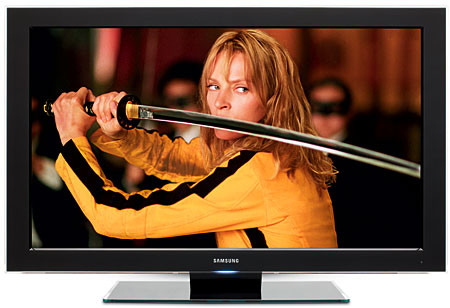
Unlike fluorescents, LEDs can be arranged in a number of zones behind the screen. Each zone’s brightness instantaneously adjusts up or down depending on the brightness of the picture. The generic name for this process is local dimming. Samsung calls it LED SmartLighting, and it promises dramatic improvements in LCD’s black level and contrast—until now, two of the most significant shortcomings of that technology.
Features
The Samsung provides ample inputs divided between the side and rear jack panels. It includes a LAN connection for a home network, which lets you use Samsung’s InfoLink Service to view news and information from the Internet. With the set’s WiseLink Pro feature, you can use a USB connection to input JPEG photos, MP3 music, and movie files. Samsung’s Anynet+ feature enables interactive control of compatible components connected to the television via HDMI. The set also offers picture-in-picture (PiP).
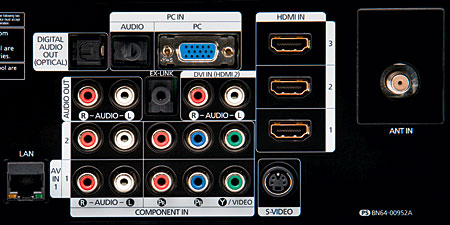
The backlit remote can control three other components. My only complaint: Since the jog wheel is so touchy, I often found myself in the wrong menu. I could live without the jog function, so I solved this by placing a narrow piece of tape across the wheel to keep it from turning.
The set has three preset picture modes: Dynamic, Standard, and Movie. Each of these can be set up individually and separately for each input. There are also two additional modes that show up onscreen when you enable them through the Service menu: Cal-Day and Cal-Night. A calibrator can set these up and either leave them open to user adjustment or lock them so you (or others with access to the set) can’t change their settings or wipe out the calibration.
Apart from the standard pic- ture controls, the only controls I used regularly were backlight (I generally set this to 2 or 3 in sub- dued room lighting), gamma, color space, white balance, and LED SmartLighting. Warm2 was the most accurate out-of-box setting for color tone (color temperature). HDMI black level should usually be set to Low when it’s accessible. A Blue Only mode lets you set the color and tint without using a blue filter.
My review sample arrived superbly calibrated in the Movie mode. In any case, the User menu provides white balance adjustments that let you adjust red, green, and blue at both the high (gain) and low (offset) end of the brightness spectrum.
 There’s also a sophisticated set of color space controls in the User menu. These provide the means, along with precision test tools and the Custom option, to accurately dial in the color points. In the Color Space Auto setting, the color points in my sample (as with the color temperature) were excellent as delivered. The Native setting is slightly oversaturated, particularly in green and red, but less so than in most modern sets.
There’s also a sophisticated set of color space controls in the User menu. These provide the means, along with precision test tools and the Custom option, to accurately dial in the color points. In the Color Space Auto setting, the color points in my sample (as with the color temperature) were excellent as delivered. The Native setting is slightly oversaturated, particularly in green and red, but less so than in most modern sets.
You should avoid the controls for Black Adjust (crushes the blacks), Dynamic Contrast, Flesh Tone, and Edge Enhancement. The latter doesn’t add obvious ringing or other artifacts, but I didn’t find that it improved the set’s already excellent definition.
The set’s audio comes from bottom-firing speakers, supplemented by two small “subwoofers” mounted on the back. While it’s a little boxy sounding, the onboard sound is above average for a flat-panel set.
As with other Samsung flat-panel sets we’ve tested, the LN55A950 has a very reflective screen. You’ll need to position it carefully to avoid distractions.
Move Me
The Samsung offers two separate features that are designed to compensate for LCD motion lag: Auto Motion Plus 120Hz and LED Motion Plus.




